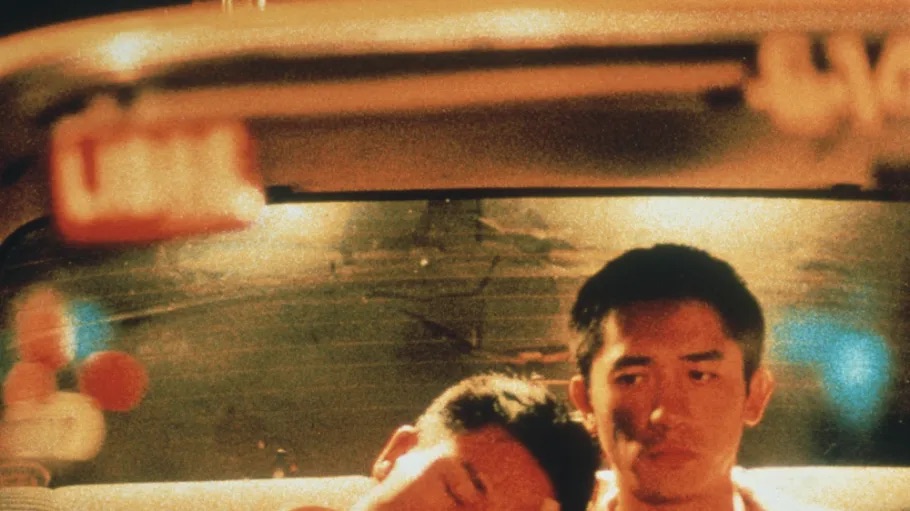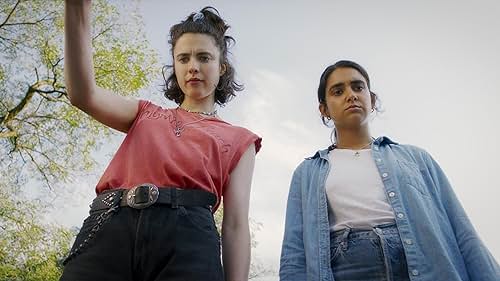Released in February of 2024, Drive-Away Dolls is one of the most recent queer-road trip films to hit screens. Directed by Ethan Coen, the film centers on two lesbians, Marian and Jamie, traveling from Philadelphia, Pennsylvania to Tallahassee, Florida. After acquiring a “drive-away” car that needs to be delivered to Tallahassee, they soon discover that they have accidentally taken a car containing penis models of at least five prominent men, including a powerful Republican Floridian Senator. Upon realizing the valuable and powerful objects they have in their possession, Marian and Jamie use the penis models to their advantage by leveraging their return to the Senator and his hired employees on their own terms—specifically, refusing to return the penis replicas until they are paid a million dollars by the Senator.
In considering what makes this film a “queer” road-trip film, I have mixed feelings on exactly how queer it is. It is most definitely a road-trip film: the majority of the movie takes place in various towns that Marian and Jamie stop in as they travel south, and the film incorporates the classic road-trip tropes of meeting unexpected people, having surprising experiences, and undergoing some sort of self-discovery in a new place. From the outside looking in, it also appears very queer—after all, the two main characters are both lesbian women and they become sexually (and romantically?) involved with each other by the end of the film. I would also argue that Drive-Away Dolls’s storyline also “queers” traditional gender roles and relations of power while simultaneously creating a lesbian utopic “elsewhere” on the road (Jagose 1994). However, it is also necessary to note that at the conclusion of the film, the final portrayal of Marian and Jamie’s relationship—despite involving two sapphic characters— rings with a note of discomforting heteronormativity and shifts the film away from being a “queer” movie and closer to being an “LGBTQ+” one, as defined by scholar Amy Borden (2016) in her work on queer versus LGBTQ+ cinema.
I believe that, apart from the main characters’ own self-identification as lesbians, one of the queerest aspects of this film is the way in which it disturbs traditional gender roles and power relations between men and women. A striking example of this is the driving (no pun intended) issue of much of the action of the film, that being the possession and control of the various prominent men’s penis models. When the Floridian Senator regains possession of the models, including his own, at the end of the film, he frustratedly says the following to Jamie and Marian: “We didn’t deserve this—this—commodification. These are all good people. Important people, too, some of them[. . .] And you little people titillate yourselves with something that was never meant for you, trafficking in other people’s.. . attainments.” This appears to be incredibly ironic coming from a man speaking to two women—a powerful man with political influence and control, no less. After all, in our traditional, patriarchal society, men exert power and control over women, including through 1. The withholding of certain resources, including political and societal power 2. Forcing women to rely on and live by the will and whims of men themselves, and 3. Reducing women to objects and taking advantage of their objectification through commodification.
These traditions of patriarchy therefore make the Senator’s accusation of immorality against Jamie and Marian very ironic. While he, particularly as a politician, has no problem using women and especially the “tiny” ones as he sees fit and profiting from their subordination, control, and objectification, he is nearly worked to tears at his first experience as the subordinated individual rather than the one in power. Jagose and her fellow queer theorists often characterize queer as a deviation from and disturbance of societal traditions, particularly those rooted in heteronormativity and patriarchy. The initial creation of the penis molds by a woman in Drive-Away Dolls queers traditional gender relations through the deviation of putting a woman in a position of power over a man, specifically through the objectification and control of his body. This queering of the patriarchy is continued over the years by the various female possession of the men’s most private body parts through acts of commodification and objectification. And at the very conclusion of the film, Jamie and Marian reassert this act of queering by not only escaping the Senator’s men that tried to regain control of the penises and thereby reinstate traditional gender roles and power relations but also by levying their possession of the objectifying items over the Senator in order to extort him for their own gain. Even after what seems to be, at least to the Senator, this final act of subordination and control over his body, Marian and Jamie continue to objectify him by secretly making and keeping copies of the Senator’s penis for themselves, thereby continuing the tradition of commodification and objectification. None of this is to say that I agree with or approve of exercising power over or objectifying and commodifying anyone in this way, but it seems undeniable to me that the continuous female power exerted over the men in this film exemplifies a queering of traditional gender roles and power relations.
The centralization of a lesbian couple in Drive-Away Dolls, specifically within their position on the road, also opens the door to what Annmarie Jagose (1994) calls “lesbian utopics.” Jagose argues that lesbian existence disrupts traditional heterosexual norms and renders them illegible. Specifically, she asserts that this disruption opens the door for new radical imaginings of politics and being, allowing for the creation of a lesbian utopia. Jagose describes this lesbian utopia as an “elsewhere” for lesbian existence, apart from the traditional cultures and politics that do not consider them and/or actively harm them. I argue that road-trips themselves create an “elsewhere” space, where time and place is unplottable and disrupts the linear patterns of everyday life. This road-trip “displacement,” as one might call it, also seems to me emphasized when those trips take place across day and night in unfamiliar and rural territories, as occurs in Drive-Away Dolls. In light of this and Jagose’s arguments, I argue that, in Drive-Away Dolls, the inherent “elsewhere” of the road and the road-trip theme combine with the main characters’ own lesbian identities and desires to create a lesbian utopic space characterized by the centralization of lesbians and their liberation from heterosexual traditions and practices.
However, despite these queer aspects of the film, I argue that Drive Away Dolls ultimately falls short as a “queer” film when it comes to the actual “queer” relationship between the two main characters. The radical opportunities offered by the film’s disruption of patriarchy and a liberatory lesbian utopia are undercut by adherence to and ultimate replication of heteronormative traditions and practices. Jamie’s character is portrayed as particularly queer throughout the beginning of the film, not simply because she has sexual relations with other women but because she appears to openly reject the heteronormative concepts of monogamy and sexual restriction. By the end of the film, however, she has abruptly recommitted herself to these heteronormative ideas of monogamy. Arguably conducting an even further departure from “queer” behavior, Jamie’s assertion that her and Marian plan to get married immediately after making it to Massachusetts appears as a devotion to what is arguably the oldest heteronormative tradition. As Michael Warner (1999) argues in his book The Trouble With Normal, gay marriage represents a departure from the ideals of queerness by committing to a longstanding heteronormative institution which privileges monogamy and allows for the systematic distinction between “good” queers (married and monogamous) and “bad” queers (unmarried and “promiscuous”).
This ultimate return to traditional and limiting heteronormative practices, which coincides with the end of the main characters’ road-trip, undermines the radical liberation created by their time on the road. It leaves Drive-Away Dolls feeling more like a LGBTQ+ film than a queer film, as scholar Amy Borden would describe it. Borden characterizes queer films as those that prioritize “deviant” queer aesthetics rather than simple queer “representation,” reject traditional “acceptance narratives,” target niche rather than mainstream audiences, and overall carry a radical rather than assimilatory political message. Drive-Away Dolls certainly starts out as a promising queer film, with Jamie in particular embodying a rejection of traditional heterosexual norms (like monogamy). By the conclusion of the movie, though, the departure from the lesbian utopia of the road and recommitment to queer assimilation through the heteronormative tradition of marriage overshadows this original queer potential. This ending squarely falls within the desires of mainstream audiences and abandons the opportunity for a radical politics, thereby classifying Drive-Away Dolls more as an LGBTQ+, rather than queer, movie.
The film’s queering of traditional gender norms and patriarchy and its embodiment of a lesbian utopia, if only temporary, should not be completely swept under the rug. However, its overall queer potential is reduced through the illustration of Jamie and Marian’s end goal being marriage. This off-the-road ending for these two characters prioritizes a departure from a lesbian utopic “elsewhere” and a return to heteronormative traditions and institutions of control, particularly over queer bodies and relationships. And, unfortunately, this rejection of a more radical politics in favor of a mainstream, assimilatory queer storyline dulls Drive-Away Dolls’s liberatory edge and ultimately characterizes it as an LGBTQ+ road-trip film rather than a queer one.
Works Cited
Borden, Amy. “Queer or LGBTQ+: On the Question of Inclusivity in Queer Cinema Studies.” The Routledge Companion to Cinema & Gender, edited by Kristin Hole et al., 0 ed., Routledge, 2016. DOI.org (Crossref), https://doi.org/10.4324/9781315684062.
Drive-Away Dolls. Directed by Ethan Coen, Focus Features and Universal Cinema, 2024.
Jagose, Annamarie. “Lesbians Are Elsewhere.” 1994. Lesbian Utopics, 1st ed., Routledge, 2017. DOI.org (Crossref), https://doi.org/10.4324/9781315021737.
Warner, Michael. The Trouble with Normal: Sex, Politics, and the Ethics of Queer Life. 1999. 1. Harvard University Press paperback ed, Harvard Univ. Press, 2000.


Leave a Reply